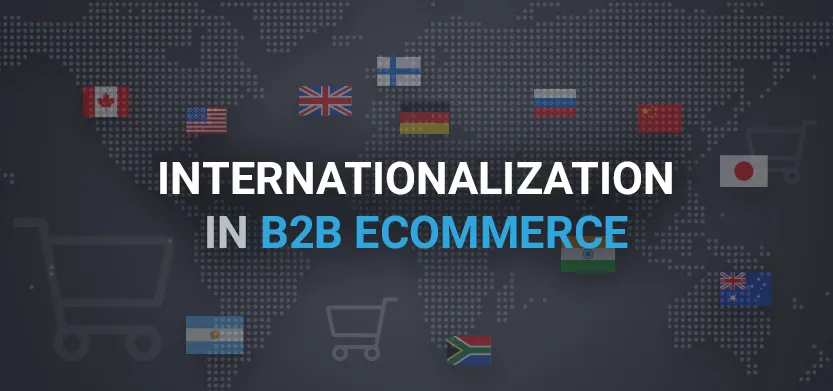
Posted in Digital Commerce
May 13, 2021
Internationalization in B2B ecommerce
In areas where your B2B business is facing a saturated market, it may be beneficial to look globally for new markets to expand into. With as many as 65% of consumers purchasing products online from outside of their own country, ecommerce internationalization, if done correctly, could be a big opportunity to curb those market share constraints.
Language and region-specific ecommerce sites offer the chance to expand your reach, enter new markets and potentially open up new revenue streams for your organization.
Keys to ecommerce internationalization
Analyze your business strategy for each country
Your business is thriving in your market, and it is time to move beyond the border. But, the strategies that got you where you are today may not be enough to award you the same success in another country. The first thing to do is to build a country and language-specific strategy for each new border you intend to “cross”.
Things to think about when building your strategies:
- Do you want your company culture to remain the same or to adjust it to the local market? Some items of your brand might translate well into a foreign market, some may not. It is important to really spend some time researching how your brand is perceived in other markets.
- Take a hard look at your prices in the new market. Simply converting your domestic pricing into another currency may not cut it. Apply the same research and analysis you originally did at home, paying special attention to the local businesses you’re about to go up against.
- Speak their language, know their culture. Customer service is key to any business, so be sure to know who will answer calls for orders being processed in your new locations around the world and who will be able to communicate to the new users in multiple languages?
- Logistics and fulfillment operations: You’ll want to weigh whether it makes sense to set up warehousing facilities in the new region, or just ship things internationally. Sometimes cross-border shipping can take weeks. But maintenance, management, and staffing of an international warehouse can be very costly.
- 1st class shipping. The trick is to invest time with your existing partners. Get to grips with their international service categories, and make sure your shipping matrix can handle the right size and weight items through the right partners.
- This is your chance to swot up on your existing operations, balancing delivery costs against the best possible end-user experience.
Create a localized website for each country
Localized content is an essential part of the ecommerce experience. 55% of consumers say that having information available in their native language is more important than the price. Localized content is a premium experience that clients are willing to pay for, so be sure to create targeted marketing strategies for each locale you intend to serve.
Tips for localization:
- Speak the same language as your customers.
- Make sure your corporate terminology can be standardized to create a consistent corporate image.
- Translation is tricky. Make sure that you have a local agency read your site before launch to make sure it is understandable. Word-for-word translations are generally not going to work in the real world.
- Translation doesn’t just pertain to the direct translation of written content on your site. The content on your site should always be implemented with technical SEO best practices in mind.
- Do your research. Even though Google is the most popular search engine in the world, some countries like China, Russia, and South Korea prefer other search engines.
- Hire a local marketing team. This is needed to understand the new market’s language, culture, and preferences.
Have accurate & immediate sales tax calculation
Every country in the world has a different way to tax goods and or services for its residents. Making sure that those taxes are correctly calculated is essential for you and your client. Integrating your existing ERP system with your ecommerce platform may be the answer to any tax compliance issues you could encounter.
- Your ERP system stores your sales tax and VAT calculations.
- Connecting your ERP to your web store will make it easier to automatically and accurately calculate taxes.
- And, it will ensure your website always displays the right sales tax amount in real-time.
Make sure your ecommerce platform is scalable
Once you have a product and content strategy implemented for a country, it is important to be able to replicate the process easily. If your ecommerce platform is holding you back, it may be time to look into replatforming to make the process simpler, scalable and more profitable.
Questions to ask when replatforming for internationalization:
- Does the current ecommerce platform support global delivery and hosting?
- Will it support localization?
- Can the existing catalogue and product content be easily translated on the site?
- How will the current platform handle multiple currencies and country-specific pricing?
Internationalization: reaching your B2B clients anywhere in the world
Building localized ecommerce experiences for your global B2B customer is the key to strong internationalization. It will allow you to grow your company through technology and automation solutions that enable you to sell your products across the globe into new B2B channels and markets without needing a physical presence in those areas. Integrating your business with third-party B2B marketplaces also helps to increase brand awareness in global regions.
If your B2B organization is on the cusp of taking on the global market, but you still have a few outstanding questions, we would love to hear from you. Acro Commerce’s internationalization strategists are here to help you reach beyond borders and grow your business.


